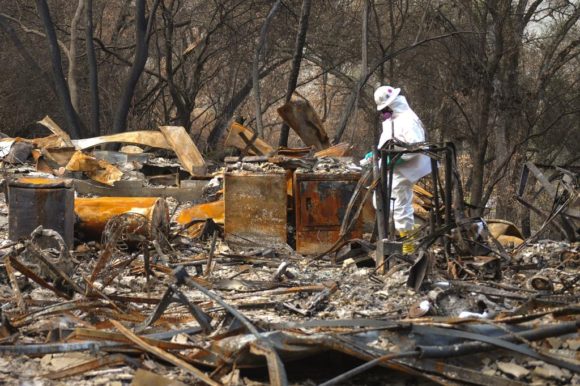A federal judge is requiring PG&E Corp. to abide by rules governing how the utility operates its power lines in California, seeking to reform what he described as “dismal” management that led to a series of destructive fires over the past two years.
U.S. District Judge William Alsup gave PG&E a March 22 deadline to present any arguments as to why his orders shouldn’t be implemented. One requires the bankrupt company to suspend issuing any dividends until it is in compliance with state laws that require it to trim or remove trees and branches growing within specified distances of its power lines.
“The record demonstrates that PG&E’s performance with respect to vegetation management has been dismal,” Alsup wrote in his order issued late Tuesday. If complying with state or federal laws is too strict, he added “PG&E’s remedy would be to seek the relaxation of such laws through its well-oiled lobbying efforts.”
PG&E didn’t immediately respond to an email and call seeking comment.
Alsup has wielded his role overseeing PG&E’s probation for safety violations like a club, threatening to subject the company to criminal sanctions if it failed comply with his plan to “reduce to zero” the number of wildfires in 2019 caused by the utility’s equipment.
But Tuesday’s order fell well short of his previous threats, drawing immediate criticism from lawyers representing victims of California’s wildfires. The blazes have burned almost three percent of the state in the last two years alone, according to the judge.
“Existing law was too lax, and PG&E was not complying with it,” said Mike Danko, a lawyer representing fire victims suing PG&E. “The judge is now saying you have to comply with existing law,” he said. “I’m not sure if it’s an answer to anything.”
PG&E hasn’t paid a dividend since September 2017, rendering one of Alsup’s demands meaningless, Danko said. Gone too are previous considerations to require PG&E to insulate or bury its most dangerous power lines. Alsup also postponed a decision about whether PG&E will have to cut power to lines during high winds.
Alsup also ordered unannounced inspections of PG&E’s compliance with vegetation management, and required the company to keep monthly records of its efforts.
PG&E said in January Alsup’s original plan to trim tree branches and inspect and repair thousands of miles of power lines would cost $150 billion this year alone, making it unrealistic.
It was in response to this complaint that the judge ruled PG&E must forego issuing any dividend payments, hire contractors and supplement any manpower shortfall by training its own crews to trim and remove trees. In 2016 and 2017 PG&E Corp. paid $1.9 billion in dividends to common shareholders, Alsup said – during the same period it failed to trim or remove thousands of trees it knew posed a fire hazard.
“Some of these dividends could and should have been kept and used to bring PG&E into compliance with state and federal law with respect to what has become the number one cause of PG&E induced wildfires,” Alsup wrote.
The case is U.S. v. Pacific Gas and Electric Co., 14-cr-00175, U.S. District Court, Northern District of California (San Francisco).
Was this article valuable?
Here are more articles you may enjoy.


 The Return Period for An LA Wildfire-Scale Event May Be Shorter Than You Think
The Return Period for An LA Wildfire-Scale Event May Be Shorter Than You Think  NYC Sues Delivery App Over Lost Pay in New Mamdani Crackdown
NYC Sues Delivery App Over Lost Pay in New Mamdani Crackdown  Tesla, EEOC Plan Talks to Settle Factory Racism Suit
Tesla, EEOC Plan Talks to Settle Factory Racism Suit  Cyber Breach Affected 750,000 Canadian Investors, Regulator Says
Cyber Breach Affected 750,000 Canadian Investors, Regulator Says 